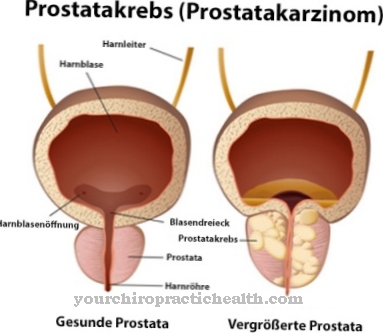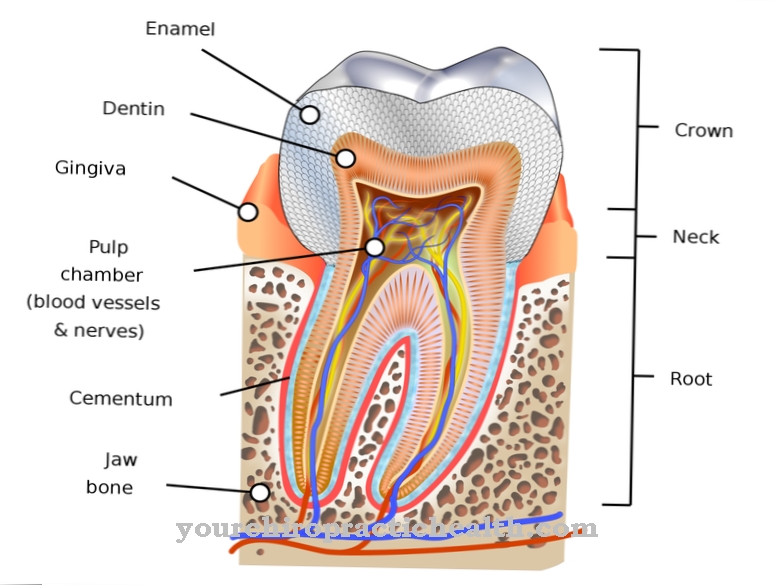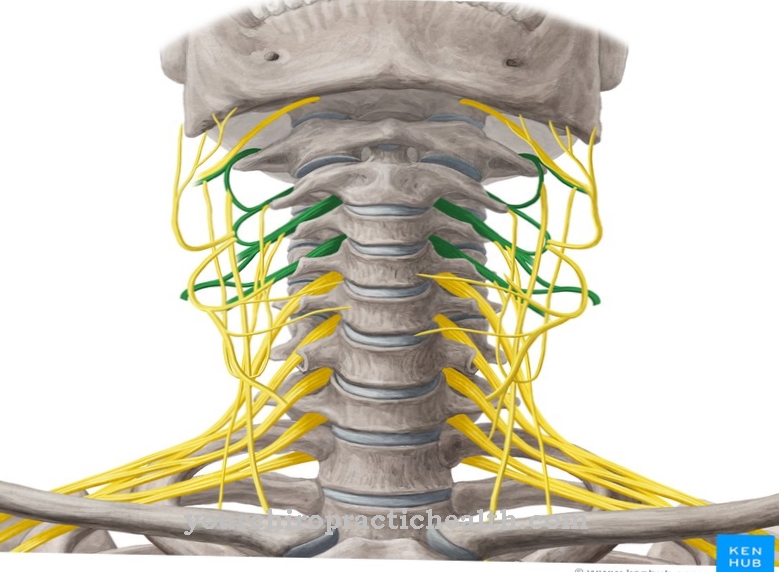The Perichondrium is the cartilage skin made of tight connective tissue that surrounds, stabilizes and nourishes all hyaline and elastic cartilage with the exception of the articular cartilage. The perichondrium contains the blood supply to the cartilage tissue connected to it. Injuries to the perichondrium can lead to cartilage damage as the supply to the cartilage is so disrupted.
What is the perichondrium?
Cartilage tissue or cartilage consists of specialized chondrocytes and corresponds to the extracellular basic substance built up connective tissue. In the form of articular cartilage, cartilage tissue covers the individual joint surfaces of real joints or diarthroses in humans, for example on the knee or hip joint.
The task of cartilage in joints is to create low-friction mobility. In addition to the joint functions, cartilage is the basic substance of the intervertebral discs and menisci. Cartilage tissue of the human body has a covering layer called the perichondrium outside the joints. The perichondrium forms the most superficial layer of the cartilage tissue and is itself made up of two layers.
Its individual layers correspond to the stratum fibrosum and the stratum cellulare. The covering layer not only keeps the cartilage alive, but also supports the regeneration of cartilage damage as it grows. Except for the joint surfaces, all the hyaline and elastic cartilages in the body have a perichondrium. In contrast, the fibrous cartilage lacks the perichondrium.
Anatomy & structure
The perichondrium corresponds to a tight layer of connective tissue and thus specialized chondrocytes. The covering layer is firmly connected to the cartilage tissue via collagen fibers. The structure of the perichondrium consists of two different layers.
The stratum fibrosum forms the outer fiber layer and consists of tight connective tissue with collagen fibers. Thanks to this layer, the connected cartilage has high dimensional stability. The stratum cellulare corresponds to the inner layer of the perichondrium. It is a cell-rich chondrogenic layer that contains fibroblasts and mesenchymal cells of the undifferentiated form. The undifferentiated mesenchymal cells can become chondroblasts or develop into chondrocytes. They are thus involved in the appositional growth of the cartilage.
In the perichondrium there is also a capillary network to supply the entire cartilage tissue. Since the covering layer of the cartilage accordingly contains many vessels and is also supplied with nerve endings, the covering layer is extremely sensitive to pain.
Function & tasks
The perichondrium fulfills several functions in the human body. All of its functions relate to the cartilage tissue that covers the envelope. On the one hand, the perichondrium has a stabilizing effect and, through its collagen fibers and elastic fibers, counteracts all tensile forces that act on the cartilage. In addition, the perichondrium is responsible for the nutrition and oxygen supply of the cartilage tissue. The tissue fulfills this supply function by means of the vascular apparatus that it carries inside.
In addition to nutrients, blood contains oxygen in both hemoglobin-bound and free form. In the human body, blood is the most important transport medium. In addition to nutrients and O2, growth factors and messenger substances are partly transported in the blood and reach their target tissues via the bloodstream. In the case of the perichondrium, the transport of oxygen and nutrients from the blood to the cartilage cells takes place in the form of diffusion within the basic substance. Diffusion is based on an undirected random movement of molecules due to thermal energy. If the concentration is uneven, more molecules move from the area of high concentration to the lower concentration.
In this way, there is a material transport that can take place without the use of energy and thus represents a form of passive material transport. Nutrients and oxygen move from the perichondrium along the concentration gradient into the cartilage and supply the tissue. The fact that articular cartilage does not depend on a perichondrium is primarily due to the so-called synovia in its joint capsule. This synovial fluid ensures the supply that is provided by the envelope layer in cartilage with perichondrium. In addition to these functions, the perichondrium can, if necessary, form regenerative cartilage in early childhood. In an adult organism, this function is only given to a very limited extent to almost no extent.
Diseases
An extremely painful disease of the perichondrium is the so-called perichondritis. This disease is an inflammation of the cartilage caused by bacteria, which usually affects the auricle and from there can spread to the inner or outer ear canal.
Usually the pathogens causing the infection are staphylococci or Pseudomonas. The pathogens penetrate the cartilage through the smallest of injuries to the skin, where they multiply. Often an insect bite is sufficient as a gateway. In perichondritis, the affected tissue typically swells up and becomes reddened. Dermal blistering can occur, which is accompanied by severe pain. If left untreated, perichondritis leads to tissue death. Injuries to the auricle can also cause permanent damage to the perichondrium located there.
The same applies to injuries to all other perichondrially covered cartilages, for example in the area of the intervertebral discs. Injuries to the perichondrium should not be underestimated because the covering layer nourishes the cartilage itself. For this reason, after cartilage injuries, perichondrial injuries or even hematomas between the perichondrium and cartilage, there is always the risk that necrosis will form in the cartilage tissue. Such necroses are not fully reversible.
In addition, due to the numerous nerve endings in the perichondrial tissue, severe pain is present in any injuries to the perichondrium. This pain phenomenon is not to be confused with osteoarthritis, which is a sign of wear and tear on articular cartilage without a perichondrium.













.jpg)

.jpg)
.jpg)











.jpg)